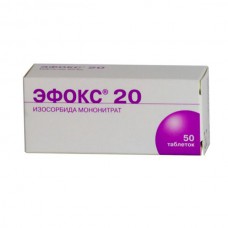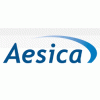Expiration date: 09/2026
The composition and form of issue:
Effox long
Tablet retard. 1 tablet contains:
isosorbide Mononitrate 50 mg
excipients: lactose 1H2O, metilgidroksipropilzelluloza gidrogenfosfat calcium 2H2O MKC polyvidone talc vysokotochnye partial glyceride magnesium stearate fumed silicon dioxide
blistere in 10 PCs. in cardboard pack 3 blisters.
Long-acting capsules. 1 capsule contains:
isosorbide Mononitrate 50 mg
excipients: sucrose corn starch lactose monohydrate magnesium silicate hydrate (talc) ethyl cellulose polyethylene glycol (macrogol) hyprolose
capsule shell: titanium dioxide (E171) iron oxide red (E172) iron oxide black (E172) gelatin
blistere in 10 PCs. in cardboard pack 3 blisters.
Efox 20
Tablets. 1 tablet contains:
isosorbide Mononitrate 20 mg
excipients: lactose monohydrate talc silica colloidal anhydrous potato starch MKC aluminium stearate
blistere in 10 PCs., in a cardboard bundle 5 blisters.
Description pharmaceutical form:
Effox long, capsules: hard gelatin capsule, size # 3, cap — brown opaque body and pink opaque.
The contents of capsules — pellets white, or almost white.
Effox long, retard tablets: white or almost white, round, beveled and a notch for a fault on one side, odourless. The slight marbling.
Evox 20: round white pills, one side is flat with chamfer, notch for fault and engraved above the notch "E", under cut — "20", the other side is convex.
Pharmacokinetics:
Rapidly and completely absorbed after oral administration, bioavailability is 90 to 100%. The time to reach therapeutic concentrations for 30 min at 100 ng/ml Cmax in plasma is 8 hours Linking blood plasma proteins is less than 4%. Isosorbide Mononitrate is almost completely metabolized in the liver. Metabolites pharmacologically inactive. Excreted by the kidneys almost exclusively in form of metabolites. Approximately 2% is excreted unchanged. T1/2 is 4-5 h.
Description pharmacological action:
Peripheral vasodilator with a predominant effect on venous vessels. Stimulates the formation of nitric oxide (endothelial relaxing factor) in the vascular endothelium, causing activation of intracellular called guanylate cyclase, resulting in an increase in cGMP (mediator of vasodilation). Reduces the need of myocardium in oxygen by reducing preload and postnagruzki (decreases diastoliceski end of the left chamber and reduces the voltage sistolicescoe wall). Having koronarorasshiryayuschee effect. Reduces blood flow to the right atrium, reduces the pressure in the pulmonary circulation and regression of symptoms oteke light. Promotes redistribution of coronary blood flow in the area with reduced blood circulation. Increases tolerance to physical load in patients with coronary artery disease.
Dilates blood vessels of the brain, the Dura mater, which may be accompanied by headache. As with other nitrates, develops cross-tolerance. After a cancellation (interruption of treatment) sensitivity to it quickly restored. Antianginal effect occurs within 30-45 minutes after ingestion and lasts up to 8-10 hours
Indications:
- prevention of angina in patients with coronary artery disease, including myocardial infarction
- chronic heart failure (in a combination therapy with cardiac glycosides, dioretikami, ACE inhibitors).
Additionally, for Effox long:
- pulmonary hypertension (in combination therapy).
Contraindications:
- hypersensitivity to the drug and other organic nitrates
- acute circulatory disorders (shock, vascular collapse)
- cardiogenic shock if the impossible correction end-diastolic pressure of the left ventricle using the intra-aortic counter pulsation or due to the introduction of funds, providing a positive inotropic effect
- severe hypotension (SBP <90 mm Hg. article and DBP <60 mm Hg. article, Central venous pressure below 4-5 mm Hg. Hg), hypovolemia
- simultaneous reception of phosphodiesterase inhibitors, including sildenafil, vardenafil, tadalafil, as they potentiate the hypotensive action of the drug
- traumatic brain injury, bleeding in the brain (Effox long)
- acute myocardial infarction with marked hypotension
- anemia (severe form)
- hereditary intolerance of galactose, lactase deficiency or malabsorption syndrome of glucose and galactose
- toxic pulmonary edema
- the age of 18 years (efficacy and safety not established).
With caution:
- hypertrophic obstructive cardiomyopathy (disease of the heart muscle with the contraction of the heart chambers), constrictive pericarditis, pericardial tamponade
- reduced filling pressure of the left ventricle, such as in acute myocardial infarction (the risk of decline in blood pressure and tachycardia, which may aggravate ischemia), reduced left ventricular function (left ventricular failure). You should not reduce the garden below 90 mm Hg. article
- aortic and/or mitral stenosis
- the tendency to arterial hypotension (orthostatic dysregulation of blood circulation)
- heart failure with low filling pressure of the left ventricle
- glaucoma (risk of increasing intraocular pressure)
- diseases accompanied by increased intracranial pressure (before the pressure increase was noted only at/in the introduction of high doses of nitroglycerin), including in hemorrhagic stroke, recent head trauma
- renal insufficiency
- hepatic failure (risk of methemohlobinemia).
Application of pregnancy and breast-feeding:
During pregnancy and breastfeeding should be used very carefully, strictly according to the doctor, after careful assessment of benefits and possible risks because there is insufficient experience with the use of this drug in pregnant and nursing mothers. If a nursing mother takes the drug, you must install the monitoring of the child concerning the development of possible side effects from the drug.
Side effects:
From the side of cardiovascular system: at the beginning of treatment may experience headache ("nitrate headache"), which usually decreases after a few days of treatment dizziness, hyperemia skin, feeling heat, tachycardia. Sometimes when first taking the drug or after increasing the dose observed a decrease in blood pressure and/or orthostatic hypotension, which may be accompanied by reflex increase in heart rate, lethargy, and dizziness and feeling of weakness. In rare cases, the strengthening of angina (paradoxical nitrate reaction), orthostatic collapse. There have been cases collaptoid state, sometimes with bradiaritmia and faint.
Gastrointestinal: nausea, vomiting, may cause slight burning sensation of the tongue, dry mouth.
CNS: stiffness, drowsiness, blurred vision, decreased ability to rapid mental and motor reactions (especially at the beginning of treatment). In rare cases, ischemia of the brain.
Allergic reactions: skin rash.
Other: the development of tolerance (including cross-to other nitrates). To prevent the development of tolerance to avoid continuous use of high doses of the drug. In some cases, — exfoliative dermatitis (severe cases of exudative erythema multiforme, impetigo common and toxicodermia).
The use of the drug may cause transient hypoxemia due to relative redistribution of the blood flow in's hypoventilating alveolar segments. It may be the trigger of ischemia in patients with coronary artery disease.
Increasing the dose and/or change of the reception intervals can lead to decline or loss of effectiveness.
Drug interactions:
Possible increased hypotensive effect when administered simultaneously with other vasodilators, antihypertensives, beta-blockers, CCB, diuretics, ACE inhibitors, antipsychotic drugs (neuroleptics) and tricyclic antidepressants, procainamide, ethanol, inhibitors of phosphodiesterase, including sildenafilum, vardenafilom, tadalafilom.
Concomitant use of isosorbide Mononitrate with dihydroergotamine may increase the concentration of dihydroergotamine in plasma and, thus, enhance its antihypertensive effect.
When combination with amiodarone, propranolol, CCB (verapamil, nifedipine, etc.) may increase the anti-anginal effect.
Under the influence of beta-agonists, alpha-adrenergic blocking agents (dihydroergotamine, etc.) may reduce the severity of antianginal effect (tachycardia, excessive decrease in blood pressure).
Barbiturates accelerate the metabolism and reduce the concentration of isosorbide Mononitrate in the blood. It reduces the effect of vasopressors.
With the combined use of M-anticholinergics (atropine, etc.) increases the likelihood of raising intraocular pressure.
Adsorbents, binders and enveloping means reduce the absorption of isosorbide Mononitrate in the digestive tract.
The therapeutic effect norepinephrine (noradrenaline) decreases at simultaneous reception with the nitrocompounds.
Be aware that the above-described drug interaction possible in case if these drugs were used just before had begun treatment with the drug.
Method of application and dose:
Inside, after eating, not liquid, squeezed small amount of liquid (e.g. 1 glass of water).
Effox long
1 table. retard or 1 caps. Effox long (50 mg) 1 times a day.
Efox 20
The dose and frequency of reception set individually, depending on the severity of the disease. Starting therapy is advisable with small doses of the drug: at the 1/2 table. (10 mg) Effox 20 2 times a day. Then gradually increase the dose up to therapeutic: table 1-2. (20-40 mg) 1-2 doses. If necessary, increase the dose to 3 tabs. (60 mg) per day. The maximum daily dose — 80 mg. the Duration of treatment and repeated courses on the advice of the doctor.
Overdose:
Symptoms: marked reduction in blood pressure with orthostatic dysregulation, palpitations, weakness, dizziness, confusion, headache, redness, nausea, vomiting, diarrhea, collapse, syncope, hyperthermia, convulsions, sweating, methemoglobinemia (cyanosis, anoxia), hyperpnoea, dyspnoea, increased intracranial pressure, paralysis, coma.
Treatment: gastric lavage in severe decrease in blood pressure and/or shock should be administered fluid in exceptional cases to improve circulation to infusion of norepinephrine and/or dopamine. Introduction epinephrine (adrenaline) and related compounds are contraindicated.
Depending on severity, in cases of methemohlobinemia apply the following antidotes:
1) vitamin C: 1 g orally or in the form of sodium salt in/in
2) methylene blue: up to 50 ml of a 1% solution of methylene blue in/
3) toluidine blue: initially 2-4 mg/kg body weight strictly I/then, if necessary, repeated administration of 2 mg/kg of body weight with an interval between doses in 1 hour
4) oxygen therapy, haemodialysis, exchange transfusion.
Special instructions:
During therapy required monitoring of blood pressure and heart rate.
With prolonged use may develop tolerance, therefore it is recommended after 3-6 weeks of regular admission of the drug to make a break for 3-5 days and replaced with other antianginal agents. If necessary, you should use the drug on the background of arterial hypotension, at the same time to introduce agents having a positive inotropic effect.
The appearance of intolerance of the drug in any case not to take it again.
Do not stop treatment with the drug. This must be done gradually to avoid unwanted effects abrupt discontinuation of treatment (the syndrome "lifting").
During the period of drug treatment should exclude alcohol.
So far there is no experience of treatment with this drug in children.
During treatment should refrain from driving vehicles and activities potentially hazardous activities, require high concentration and psychomotor speed reactions.




